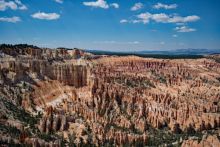Geoscience Currents transmit snapshots of the many facets of the geoscience profession, in-depth case studies of how geoscience is applied, factsheets that provide rigorous introductions to a range of geoscience topics, workforce trends, and career paths.
Partner with us to help support well-informed public policy and decision making with expert, impartial geoscience information. Visit our Sponsorships page for more information or email sponsorships@americangeosciences.org.
Displaying 191 - 200 of a total of 350 items

November 21, 2017
Field camp costs (all in U.S. Dollars) were pulled from syllabi and webpage sources for 63 US-based institutions offering a field camp course. These sources provided varying levels of detail in regards to the cost of their respective camps. "In-state" costs (in-state students or students enrolled...

October 19, 2017
AGI’s Geoscience Student Exit Survey has been conducted with graduating students completing their bachelor’s, master’s, or doctoral geoscience degrees for the past 5 years. AGI followed up with approximately 1250 recent graduate respondents. This follow-up survey investigated their career path up...

September 29, 2017
Currents #119 investigated the representation of women in geoscience faculty positions in the United States. To extend that conversation of gender representation in the geosciences, NSF’s 2013 restricted-use data file integrating the National Survey of College Graduates and the Survey of Doctoral...
September 25, 2017
Why water storage?
A reliable water supply is essential for economic, environmental, and public health, but natural water supplies vary with the seasons and between years. Water storage, whether in reservoir lakes or underground, helps to ensure that water is available even during droughts....
September 25, 2017
The Need for Groundwater Management: Sustaining water supplies and preventing hazards
In California, surface water from rainfall, snowmelt, and distant rivers rarely meets the state’s urban and agricultural water needs. Groundwater is an essential water source, providing 35% of the fresh water...
September 07, 2017
What is a Dry Well?
A dry well is a well that is used to transmit surface water underground and is deeper than its width at the surface (see image, below). Most dry wells are 30 to 70 feet deep and 3 feet wide at the surface. They are lined with perforated casings and can be filled with gravel or...
September 07, 2017
Introduction
Dry wells improve stormwater drainage and aquifer recharge by providing a fast, direct route for rainwater to drain deep into underlying sediment and rock. Dry wells are most common in the western U.S. where clay or caliche layers slow down the natural drainage of water into...

August 17, 2017
Between 2006-2016, the percentage of female geoscience faculty increased from 14 percent to 20 percent of the geoscience academic workforce. The largest growth was seen at the Assistant Professor rank with an increase of 11 percentage points. The increase of women in geoscience faculty positions...
July 13, 2017
Background
In areas prone to winter precipitation, transportation infrastructure must be able to quickly respond to snow and ice on roadways. Ice removal is a vital service in these communities. Deicing chemicals melt ice by lowering the temperature at which it melts. They can also prevent new ice...

May 24, 2017
Since 2013, AGI’s Geoscience Student Exit Survey asked about internship participation among recent geoscience graduates. Consistently over the past four years, participation rates have been much lower than expected, particularly among bachelor’s and doctoral graduates. In 2016, 35% of bachelor’s...
Pages
Upcoming Webinars


